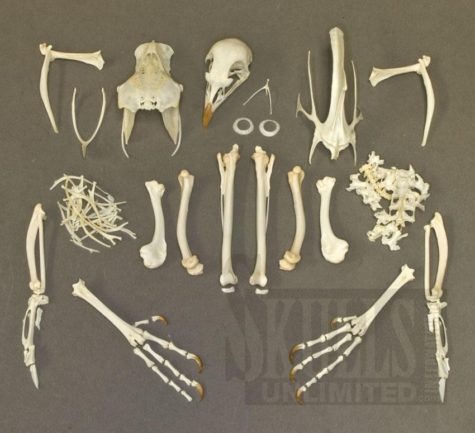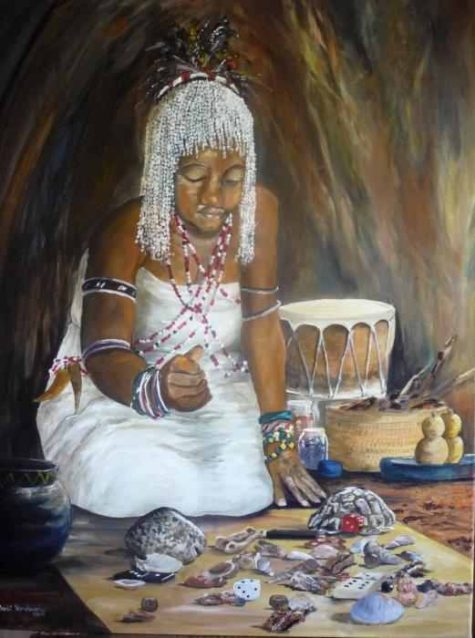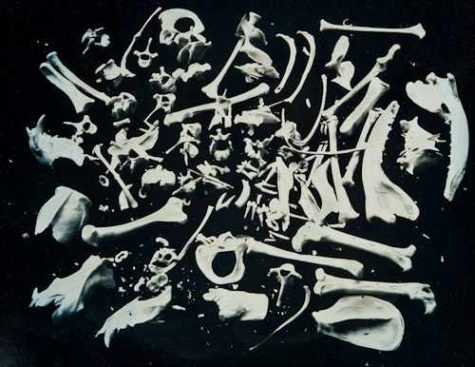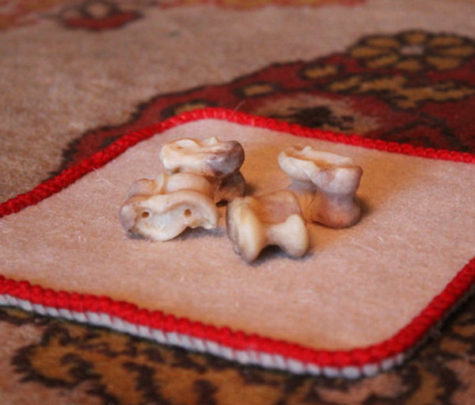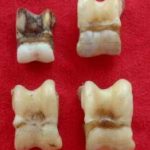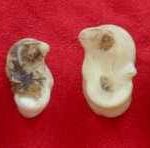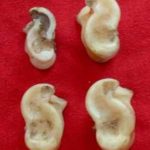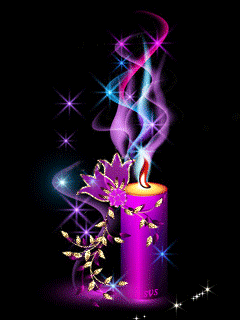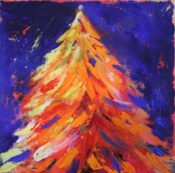Bones
Divination by Chicken Bones
Divination by Chicken Bones is a tradition among the Kammu in northern Lao People’s Democratic Republic.
The ceremonies, rites and rituals have never been written down by the Kammu, since it is a language which has no script. So, not only the performance but also the significance and the deeper meaning of the various ceremonies and rites are now being forgotten. Even the rather simple rituals such as divination may soon belong to history.
Using chicken bones to predict our future:
We Kammu believe in fate, and hope that fortune is to come. But no one can see his own fate nor know his future. We can, however, use the chicken bones to divine what lies in store for us. This is done by sacrificing a cock or a hen and using the thigh-bones to find out our good or bad future, or good or bad luck.
There are various ceremonies, some for the ill, others for those who are about to start the certain work in the fields, and there are special ceremonies for unhappy as well as for happy occasions.
Divination follows the sacrifice of the bird and is considered a minor ritual. Not only the shaman, a priest-doctor, but any elder or knowledgeable person can perform a divination by chicken bones; providing they are able to interpret the result and understand what measures should be taken.
If the diviner predicts bad luck, we must listen and try to find the ways to protect ourselves.
How to divine by the chicken bones:
We ask the spirits what is going to happen in the future by counting the holes in the thigh-bones of the sacrificed chicken. We look closely at the shaft of each bone to locate the holes. The holes reveal good luck or bad luck, this depends on the type of ceremony performed and what we wish for. Small, thin bamboo sticks are used to show where the holes are and how they slant.
Ceremonial occasions:
When we are going to burn the fields we sacrifice a hen to feed the spirits of the area. We then ask the spirits about good and bad fortune, if the rice will grow well or not and if the people may live well in the coming year. This ceremony is done in April.
- We know by reading the signs of the hen bones if we are going to be healthy or not and if it will be a good harvest or a poor one.
When we call upon the rice to grow well and want to drive away the spirits of waste, we sacrifice a black hen to feed the rice souls. The black hen means that the fields will be covered with rice, “black with rice” we say, so that we are unable to see the ground. This ceremony is done in June.
We make similar sacrifices when we call upon the rain to fall or want to drive away the insect spirits.
When we start to use the new rice, we sacrifice a brown hen to feed the rice souls. We want to know if our new rice is going to last for a short or long period. This ceremony is done in December.
When we are going to travel we ask the village spirits and the house spirits, whether we travel safely or not, and whether we will have good luck on our journey. We find out from reading the signs not only of the bones but also of the feet and tongue of the sacrificed hen.
When we want to welcome someone we respect and love we sacrifice a hen before performing a ceremony in which we read the signs in the bones, feet and tongue of the offering.
Below seven of the many possible configurations are explained.
Chicken bone divination
The birds right bone belongs to “us”, that is to say the person who performs the divination and his group. The left bone belongs to “others”, that is to say to spirits, illness, unhappiness, and to other people or to good things, such as happiness, health and wealth.
When the right bone indicates good, it means that we will have good fortune and be lucky, but if the right side bone indicates bad, it means that we may meet with poor fortune and bad luck.
If there are more sticks pointing to the upper end of the bone than to the lower end, it means that our head is stronger than our feet. In this case we are going to have good ideas, our mind is strong and we are able to overcome all difficulties. Thus this is a very good sign for us.
If there are more sticks pointing to the lower end of the bone than to the upper end, it means that our feet are stronger than our head. In this case we will have no ideas, our mind is weak and we are unable to overcome our difficulties. We are probably going to lack rice and other kinds of food which means we must find sustenance in other villages. Thus this is, of course, a most unfortunate sign for us.
Protecting against bad luck and illness:
When bad luck and fortune are predicted we must try to protect ourselves, otherwise we cannot work in our fields because someone in the family may fall ill or die.
When we read the chicken bones, we must thus note which end of the bone is the upper end and which is the lower. As has been said, upper end means “head”, lower end means “feet”.
In the following pictures, all the bones are placed with the “head” upwards. Which bone is the left one and which is the right one must also be into account. If the diviner does not know all the signs, he can never find the right answers to the questions.
Traditional explanations of what the chicken bones tell us:
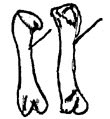 In this illustration, as there is only one hole in each bone there is also one stick on the right bone and one on the left. Since both sticks are pointing towards the upper ends, we can see that we are strong in our heads. Both sticks are also standing almost upright, this is a good sign both for the ego and the others (spirits, bad luck and illness).
In this illustration, as there is only one hole in each bone there is also one stick on the right bone and one on the left. Since both sticks are pointing towards the upper ends, we can see that we are strong in our heads. Both sticks are also standing almost upright, this is a good sign both for the ego and the others (spirits, bad luck and illness).
Our minds are thus very good and strong, we have a good ability and we master all difficulties. We are working with our strong minds, and are healthy and live happily in this period.
On the other hand our feet do not work so much, we are to spend most of our time at home, and there is not to be any travelling in the nearest future. This means that we have got enough food, rice and money at home. We need not go to buy necessary things from other villages, and that means good fortune and good period.
This configuration means only good for us, and we may live in peace with our enemies, not be hunted by spirits or any kind of illness.
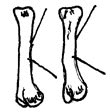 In this illustration we see two sticks on each bone, the sticks point to both towards the upper and the lower ends of the bones. The two sticks which point to the upper ends are slanting heavily in relation to the bones, a sign of weakness. Our head and our mind are therefore weaker than our feet.
In this illustration we see two sticks on each bone, the sticks point to both towards the upper and the lower ends of the bones. The two sticks which point to the upper ends are slanting heavily in relation to the bones, a sign of weakness. Our head and our mind are therefore weaker than our feet.
When our head is weaker than our feet, we have to use our feet more than our head which means that there is not enough food and rice so that we have to go and buy it from other villages. We are not able to overcome the difficulties in the period to come. People may fall ill more frequently so that both our enemies and the spirits are able to overcome us. If people often fall ill, they are unable to work in the fields. This is the reason why there will be a lack of rice and food, so that we have to travel to look for it.
We know this because the sticks pointing to the upper ends are leaning, while those which point downwards stand almost upright. We call this particular configuration “strong feet and weak head”. Standing sticks indicate strength, leaning ones weakness.
In this picture the sticks on the right bone, “our” bone, are standing slightly more upright than those on the bone of the “other’s”. So despite the fact that we are not very strong, we are yet stronger than our enemies, illness and spirits, and this is good.
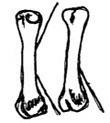 Here we see three sticks on the bones, two on the left one and one on the right. Only one stick is pointing to the upper ends, and two of them are pointing to the lower ends, a prediction of headaches. It tells us that our heads are weak but our feet are strong. Sickness, bad spirits and problems may overcome us.
Here we see three sticks on the bones, two on the left one and one on the right. Only one stick is pointing to the upper ends, and two of them are pointing to the lower ends, a prediction of headaches. It tells us that our heads are weak but our feet are strong. Sickness, bad spirits and problems may overcome us.
All three sticks are slanting so we will be quite weak during this period and sometimes suffer from slight headaches. Only one stick is pointing upwards. We can therefore see that our minds are weak and once again, we are in for an unsuccessful, sad and sorrowful period. We cannot overcome this weak condition as our minds do not function well.
There are two sticks on the left bone and only one on the right one, “our” bone. This is very negative for us, but very good for the other side, and bad situations are to encounter us, and we can easily be defeated in everything we do.
That there is only one stick on the right bone indicates that we are weaker than others, and we are therefore unsuccessful in all our undertakings. This is not a good configuration for us at all, but very good for our opponents.
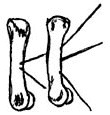 Five sticks have been used in this case, three of them are pointing towards the upper ends, and two are pointing downwards. Five sticks is most uncommon, and it means that something strange and very unusual is going to happen to us in the near future.
Five sticks have been used in this case, three of them are pointing towards the upper ends, and two are pointing downwards. Five sticks is most uncommon, and it means that something strange and very unusual is going to happen to us in the near future.
Sometimes it may be positive and mean that there will be an abundance of rice, for instance, or that we have luck in catching a large animal to eat. On the other hand it could be a negative sign and mean that someone in the family falls seriously ill. Whatever it is, it is unusual enough to warrant a big feast or ceremony in the family house.
Since the signs mean that strange things are going to happen to us, we must be extremely careful. Especially because the chicken bone prediction can mean either good or bad. There could, for instance, be a big argument if we are not sufficiently careful.
If we get a good harvest or if one of our traps catches a large animal, the whole village celebrates it with a big feast in our common-house. On the other hand, if someone falls ill, we must slaughter a water-buffalo in order to have a suitable ceremony for our ancestors, otherwise the sick person could die. Whatever the case, there will be a big feast with many visitors in our house.
Both our mind and our feet are strong according to the result of this divination. Nothing can overcome us, because our strength is supported by the many people who come to our help if need be. The stick in the middle of the right bone indicates helpers.
If there are three sticks on the right bone this is a good sign for us, but if there are three sticks on the left bone, the sickness or spirits will come to us. The three sticks on the right bone in this illustration means that we are stronger than our opponents and we would be able to master all our problems.
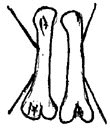 There are four sticks in this illustration, two are pointing upwards and two downwards. On the right bone the sticks are standing upright, which means that “our” side is stronger than our opponents.
There are four sticks in this illustration, two are pointing upwards and two downwards. On the right bone the sticks are standing upright, which means that “our” side is stronger than our opponents.
We are stronger than others, and we may solve every kind of problem. We will be healthy, have a good fortune and get a good harvest, we may even earn more money. Good things, happiness and peace are coming towards our direction during this period.
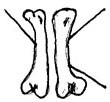 This illustration shows three sticks on the bones. There is one stick pointing to the upper end of both bones and on the right bone one stick is pointing to the lower end, this indicates that we are stronger than others. In fact, because “our” bone has two sticks and the “other’s” bone only has a single stick, the prediction tells us that we are stronger than sickness, spirits and other problems.
This illustration shows three sticks on the bones. There is one stick pointing to the upper end of both bones and on the right bone one stick is pointing to the lower end, this indicates that we are stronger than others. In fact, because “our” bone has two sticks and the “other’s” bone only has a single stick, the prediction tells us that we are stronger than sickness, spirits and other problems.
It all means that good things are going to happen to us, and we are able to get everything we wish. Both people and domestic animals are able to live well and have a pleasant life. Our rice grows well and covers the fields, and our traps will catch many large animals in this coming period.
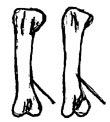 In this picture there is just one stick on each bone and both of them are pointing down, the opposite to the sticks in the first illustration, and the prediction is, of course, also the opposite.
In this picture there is just one stick on each bone and both of them are pointing down, the opposite to the sticks in the first illustration, and the prediction is, of course, also the opposite.
When signs like these show us that bad fortune or bad luck is coming, we must prepare a new ceremony. This may protect us from the evil and unpleasant experiences looming ahead. We can expect evil spirits, illness, sadness or problems to appear to us during this period.
If we do not protect ourselves now, we will probably be unable to work in our fields as someone in the family probably falls ill or dies. Our head is weak here and the strength is in our feet. As we are suffering a shortage of rice and food, we have to look for food in other villages.
The constellation here is most unlucky and speaks of serious difficulties ahead. We call this particular configuration “headache”. Strong feet and weak head.
About the writer:
This article was written by Damrong Tayanin (Kàm Ràw), and was found at the Kammu website. Here’s a short bio:
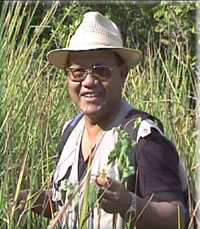 I am a Kammu, and I was born in 1938 in a traditional mountain village in the northern part of the Lao People’s Democratic Republic. In my youth I was trained to be a shaman by an uncle of mine, and I have also received training to collect and use medical plants by my uncle Torm.
I am a Kammu, and I was born in 1938 in a traditional mountain village in the northern part of the Lao People’s Democratic Republic. In my youth I was trained to be a shaman by an uncle of mine, and I have also received training to collect and use medical plants by my uncle Torm.
In 1972 I left my home village and went to stay with my brother-in-law 40 kilometers outside of Huay Sai. Just a few weeks later I met Dr. Kristina Lindell, a Swedish linguist and folklorist, in Chieng Khong in Thailand. She invited me to come and work in the Scandinavian Institute of Asian Studies field station in Lampang. There I began my new life’s work of recording Kammu folklore and traditions.
In 1974 I went to Sweden with Dr. Lindell. There I also started to work with several other researchers on a long series of Kammu projects where we have endeavoured to document and preserve as much as possible of traditional Kammu culture.
We have interviewed and co-operated with hundreds of Kammu men and women living in Thailand, China, and after the end of the war in the United States and France, where many Kammu live as refugees. It is, however, only during the last few years that we have been allowed to work in villages in Laos, where the ancient religious rituals and traditions of the Kammu are remembered by elderly people. Working with them we have learned that they no longer teach their children the rituals.
Divining with chicken bones is just one fascinating aspect of Kammu culture, a dying and almost forgotten society.
The Zulu Bone Casting Tradition
I found the following post while browsing the Magic Cafe Forums, and decided to share it here since I’ve been posting about bone divination. It’s informative and thought provoking. Enjoy!
I’m a Sangoma Traditional Doctor, received my initiations and completed ‘thwasa’ in Swaziland under Zulu Elder and Master Sangoma PH Mntshali.
Diagnosis and divination with bones isn’t something you’re going to find a lot of written information about because the information is passed through ancestors and an oral, shamanic tradition.
A man by the name of David Cumes is a both a wonderful traditional healer and medical doctor, a past associate of mine and one of the other three Sangoma TDR’s here in the States. He wrote a wonderful book about his thwasa and initiations in the Zulu Mystery Traditions titled, Africa in my Bones that’s as good a resource as you’re going to find regarding the Zulu bone casting tradition and this ancient practice.
Personally I have mixed feelings about this. I would hate to see a magician collect a few bones, toss them with some cold reading lines and call it ‘Zulu.’ This is part of my spirituality, something I worked very hard and very long to honor, traveled half way around the world to learn more about, submerged myself into the Swazi and Zulu culture, learned their language, underwent their intense rituals, training, traditions and initiations to ‘qualify’ for the bones I use and to incorporate this ancient, powerful mouthpiece for the ancestors. It’s not a magic trick, it’s not a presentation to throw in a show and not something I take lightly or would like to see ***ized…not saying those are your intentions for studying such a thing, of course.
That said, I think it’s very important to draw attention and interest to these traditions, rites and customs in the interests of cultural preservation and keeping the world’s shamanic traditions and root spirituality intact. Anytime someone is interested in learning more about the Bones and especially their use in the Zulu Sangoma tradition I’m more than happy to speak about it and would be honored to be of special assistance. To answer your question, while I think anyone could learn to use and interpret the bones I don’t think everyone should…
Does one have to be initiated or become a Sangoma to use the bones? No, not always. I’m not sure about other religions or traditions though. Many people feel pulled to this system and end up for extended stays in South Africa living on a Zulu homestead and being mentored specifically in the use of bones for diagnosis and divination without becoming a traditional doctor, Inyanga or Sangoma.
There’s a lot that goes into a Sangoma’s bone set. The animals are obtained through tradition, offered to the ancestors (their blood will be on your hands and in your stomach), consumed (all parts and portions, nothing spared), the proper bones obtained, washed, blessed and brought to life through ritual.
Each bone piece in the Sangoma’s set is hidden from them during thwasa to be found and located while in ecstatic trance and deep shamanic states. It’s up to the sensitivity of the thwasa and their guiding spirits that determines how fast the bones are found and incorporated. For some it might take 5 to 7 years before the proper tests are passed. I successfully located 28 of the 37 bone pieces in my own set. It was no easy task.
The bones are bonded to the healer/diviner and his helping spirits through drumming, rattling, singing, dancing, chanting and praying, ancestral offerings, ecstasy, muti rituals, blood letting and intense purification ceremonies. This is the norm whether the student goes on to become a Sangoma or not.
Day and night the student is mentored in the traditional meanings and interpretations which are also ancient, sacred to the Zulu’s and have remained largely unchanged throughout time. The bones are very simple objects and yet advanced and complex in their use – a single bone piece can have over a dozen different meanings depending on which side is showing, where it falls in the casting, its proximity to other bones, etc. As this information is imparted the student is an apprentice to his Mama and Baba whom he works for and pledges himself to for the remainder of his experience. A special bond is formed during thwasa between man, animal, earth and ancestor. The process itself is incredibly dynamic.
During the long periods of learning to work with the bones one is expected to work in a traditional clinic (mine was the Luvenga Traditional Clinic in Matsetsa) and to see clients for traditional healing and diagnosis/divination many days a week.
If NOT a traditional healer, the students of this special shamanic, ancestral wisdom and system of divination with bones is still required to practice and utilize what is learned during the teaching and integration process with dozens of people, clients and patients each day for months on end. Only this way is a level of proficiency attained – one isn’t going to pass the qualification ceremonies and initiatory process with cold reading lines or revised Tarot readings.
There would be mornings I would wake up (around 4:00 a.m.) and prepare for my daily rituals and purification ceremonies which happen EVERY DAY while learning to work with bones. I would receive hours of instruction with Baba Mntshali and Sipho Mamba, Miriam Mntshali and other elders before travelling by foot many miles to the clinic with my adoptive family and local healers to begin seeing patients for the day. Many days we would arrive with 50 or 60 people already waiting and I would work 14-16 hours a day – needless to say, I got a lot of practice working with my bones in the process. This is something that cannot be taught in a book or learned from a book.
If you’re considering Zulu specific divination ceremonies I would strongly advise doing what I did and preparing for Africa. There you can learn in the ancient fashion, according to tradition as part of a true shamanic lineage. It’s a lot of work, blood, sweat and tears (all of which will be added to your bones) and I can only say it was the most worthwhile and precious experience of my life. Anything less would be stealing from the culture, history, legacy and tradition of another. We’ve got to keep in mind the process exists for a reason and was never intended to be used for entertainment.
I hope this post doesn’t sound harsh or come across as condescending or disenchanting in any way…it might, though it’s not my intention. I would be more than happy to assist you in creating or finding a working alternative. I’m completely open to the possibility of one using bones in their readings, in an ethical and respectful manner and always by properly representing the bones and the traditions one claims is associated with them (and you), being honest and forthcoming about the ‘credentials’ claimed, etc. Not all bone casting is Zulu – as you said Santeria, Hoodoo and other mystery traditions, magickal systems, religions and spiritual paths incorporate them too.
Loren always does a great job with his products, but this is the first I’ve heard about it and I wish I didn’t. Obviously I feel very strongly about this practice and have my reasons for doing so. Divination with bones is something very spiritual and sacred to me in the deepest sense and I’m hesitant to think of what might happen to bones in the public eye after a bunch of magicians get ahold of them, treat them like another cool gimmick or toy and use them as an interesting premise for their recycled, canned readings and stock CR lines. There is a proper way to learn the bones and I refuse to believe it’s through an ebook or package from Mevpro, although I’ve no doubts that it will beat the alternative offerings mentalists and psychic entertainers currently have access to.
Regarding your own use and study of the bones in the Zulu or any other tradition, I’m 110% for it and as I said before, I would be happy to assist you in this regard. I guess what worries me most here (and something completely unfounded at this point and I’m likely just being protective and paranoid – again, no offense is intended – please know that!) is anyone who might wish to misrepresent themselves in this area or use questionable techniques in their presentations with such tools and oracles.
I’m also of the belief a non-cultural specific system for bone readings is warranted and if this is the way one wishes to go (and I’m sure now that I think about it is exactly what MevPro is doing) can be very effective and beautiful. If anyone wishes to explore some options in this area I will gift the right people with African lion bones for use in their divination and casting sets. I also know Scully Elly offered a beginning bone casting kit with weasel, chicken, snake and other bones. I’ve recommended this set for close friends who were serious about studying and applying a legitimate system for divination with bones.
My sincere apologies for this post coming across as a rant. I feel like I sound like a raving lunatic right now and if you could SEE me at this point I’m really being anything but that!
I want to help those who wish to work in this area to the best of my ability. The bones are not mine to control or dictate who uses them or what for or how. I do feel responsible to speak on this matter though because the Zulu systems and traditions were mentioned in the original post. I’d be happy to speak of this more via PM and will again recommend Dave Cumes book, ‘Africa in my Bones’ for those who wish a deeper ZULU SPECIFIC knowledge in this area.
Thokoza,
Jerome Finley, TDR
Reading Possum Bones
This I have never seen done, only heard it described by an African-American woman born in Tennessee whose grandfather did it, circa 1945-50, when he was very old and she was young. She told me that he would only read the bones outdoors in the yard, sitting on the dirt and throwing them into a circle drawn in the dirt.
She asked me if I knew enough about reading possum bones to refresh her childhood memories of her grandfather’s method, but alas, I did not; however, according to Eoghan Ballard of the University of Pennsylvania, this woman’s grandfather was throwing the bones according to a system used by Bantu people throughout Southern Africa; the bones are usually knuckle bones, marked with dots and crosses.
The reading of knuckle bones led, quite naturally, to the use of dice in divination, and in America dice reading, especially when performed according to one of the popular 19th century French methods, has more or less replaced reading the bones among African-Americans.
Source: Lucky Mojo
Shagai – Throwing The Bones
Shagai refers to the astragalus of the ankle of a sheep or goat. The bones are collected and used for traditional games and fortunetelling throughout Central Asia, and games involving the ankle bones may also be referred to by the name of the bones. They may be painted bright colors.
Such bones have been used throughout history, and are thought to be the first forms of dice. In English language sources, shagai may be referred to as “ankle bones”, and playing with shagai is sometimes called ankle bone shooting.
Among the Mongolians, four unmarked sheep astragalus or knuckle bones are thrown, each of which has four distinguishable sides, which produces an array of 36 possible answers to any given question. The name for this system of divination is shagai, often rendered in English as “Complicated Fortune Telling.” In addition to functioning as a system of divination, shagai can also be played as a gambling game.
Shagai games are especially popular during the Mongolian summer holiday of Naadam. In shagai dice, the rolled shagai generally land on one of four sides: horse, camel, sheep or goat. A fifth side, cow, is possible on uneven ground.
- Goat
- Sheep
- Horse
- Camel
In fortunetelling, four shagai are rolled on the ground; the two convex sides, horse and sheep, are considered lucky, with horse being the luckiest. The sides with concave indents, goat and camel, are deemed unlucky; rolling all four sides on one throw is considered indicative of very good fortune.
Mongolians still exchange shagai today as tokens of friendship. The shagai may be kept in a little pouch. In addition, Mongolians (usually male) also collect wolf shagai, which are viewed as good-luck tokens.
Source: Wikipedia
Throwing The Bones
In bone divination, bones of various sorts are ritually tossed onto a mat, an animal hide, or into a circle drawn in the dirt, and the resulting patterns interpreted.
Throwing the bones is an ancient practice traditional to many regions of the world, including Africa, Asia, and North America. The number and type of bones employed, as well as the inclusion of other small objects, such as pebbles, shells, and hard nuts, varies quite a bit from culture to culture.
In the traditions of some cultures, the bones, shells, and/or nuts that are to be thrown are left in their natural state; in other cultures they may be shaped and marked, much like dice, dominoes, or the cut cowrie shells used in Obi and Diloggun divination.
Marked bones are often used in groups of two or four to obtain yes or no answers, as well as more detailed information. There is quite a bit of evidence to support the idea that gaming dice, often casually called “the bones,” may have had their origin in marked bone divination, as there are still forms of divination in which the markings of the spots and dots on dice or dominoes are used to read fortunes for clients.
As a hoodoo practice, casting or throwing the bones has deep traditional roots in African culture, especially as developed among the sangomas or divining healers of the Zulu, Swazi, Xhosa, and Ndebele traditions in southern Africa. Trained as herbalists, spirit mediums, and diviners, they fulfill an important role in their culture, equivalent to that of a root doctor in the United States or an obeah practitioner in Jamaica.
Mingling of African traditions with Native American and European forms of divination have produced quite a lot of variation in hoodoo practices. Traditional items used by Southern-style hoodoo doctors and spirit-led fortune tellers who employ these ancient methods of divination include bones, stones, coins, stalks, or shells. Additionally, some who follow this style of divining with natural curios may also perform augury by inspection of natural botanical and zoological curios such as owl pellets.
According to Catherine Yronwode, a well known author and practitioner in the world of Hoodoo, there are three basic forms of bone divination:
- Heated and cracked bone reading:
a form of Pyromancy. Usually done by heating the shell of a turtle, ox scapulae, or turtle plastrons in fire and then interpreting the cracks that form. This began and was primarily practiced in ancient China, in the late Shang Dynasty. - Mathematical systems of bone reading:
Geomancy. An example of this is Hakata, a very interesting form of divination found in Africa, where one would interpret hand-made tablets by the markings inscribed there on. - Spirit-led interpretive bone reading:
Cleromancy. This is a Shamanic from of divination. It is used, and varies greatly, among many different cultures and beliefs. A wide array of animal bones are used in Shamanic bone reading. The bones carry different meanings and energies according to what animal they belonged to, and what type of bone it is (tooth, claw, hand bone, etc.)
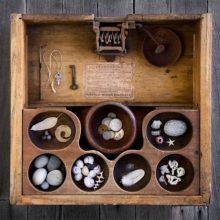 Although there is no single system of bone or curio divination used by all African American practitioners, some old-timers read a set of chicken bones or ‘possum bones, and do so only on the ground rather than a table-top, after the manner still practiced in Africa to this day. Others mix pebbles with their bones, as some sangomas do, and might read on a table-top — but no matter what natural curios are included, the practice is still called “throwing the bones.”
Although there is no single system of bone or curio divination used by all African American practitioners, some old-timers read a set of chicken bones or ‘possum bones, and do so only on the ground rather than a table-top, after the manner still practiced in Africa to this day. Others mix pebbles with their bones, as some sangomas do, and might read on a table-top — but no matter what natural curios are included, the practice is still called “throwing the bones.”
Hoodoo bone readers consider it traditional to keep their divination bones in a basket, bowl, or bag on or near their altar when not in use and to cast them out onto a mat, a hide, or a circle to read them, which are African techniques of working. Each bone may have a meaning, and the patterns among the bones may be significant as well.
For example, in one family tradition, nine chicken bones are used, and each bone has a meaning:
- wing bone signifies travel
- neck bone signifies poverty
- wish bone signifies good fortune
In addition to being used in rites of throwing, bones are also ritually manipulated in other ways for the purpose of telling the future for a client. For instance, they may be burned in a fire and the resulting chars and cracks examined in order to determine specific answers.
Bones, as well as other body parts, may also be used as a means to communicate mediumistically with the dead and with spirits, through psychometry.
Many diviners believe that one’s set of bones should be special and unique to the individual. You simply cannot go out and buy a bone divination set. Bones can be gathered, bought, obtained from different sources, but the completion of the set and power lay with the the individual’s personal contributions.
Practitioners of Hoodoo will use a wide array of bones along with artifacts or game pieces to represent a specific person. The Sangomas, an African people who greatly influence the Hoodoo tradition, believe that it is their ancestors speaking through the bones; so to aid in communication, will carry a porcelain doll head containing dirt from the grave site of the ancestral spirit they work with.
Among the Mongolians, four unmarked sheep knuckle bones are thrown, each of which has four distinguishable sides, which produces an array of 36 possible answers to any given question. The name for this system of divination is shagai, often rendered in English as “Complicated Fortune Telling.” In addition to functioning as a system of divination, shagai can also be played as a gambling game.
Source: Readers and Rootworkers and Mama Bee’s Blog
Debbie: Reading Candle Wax
Bridget Grimes: 310112_svyatki2_500
Mari: Reading Candle Wax
Ali: Notarikon
ALI: Notarikon
